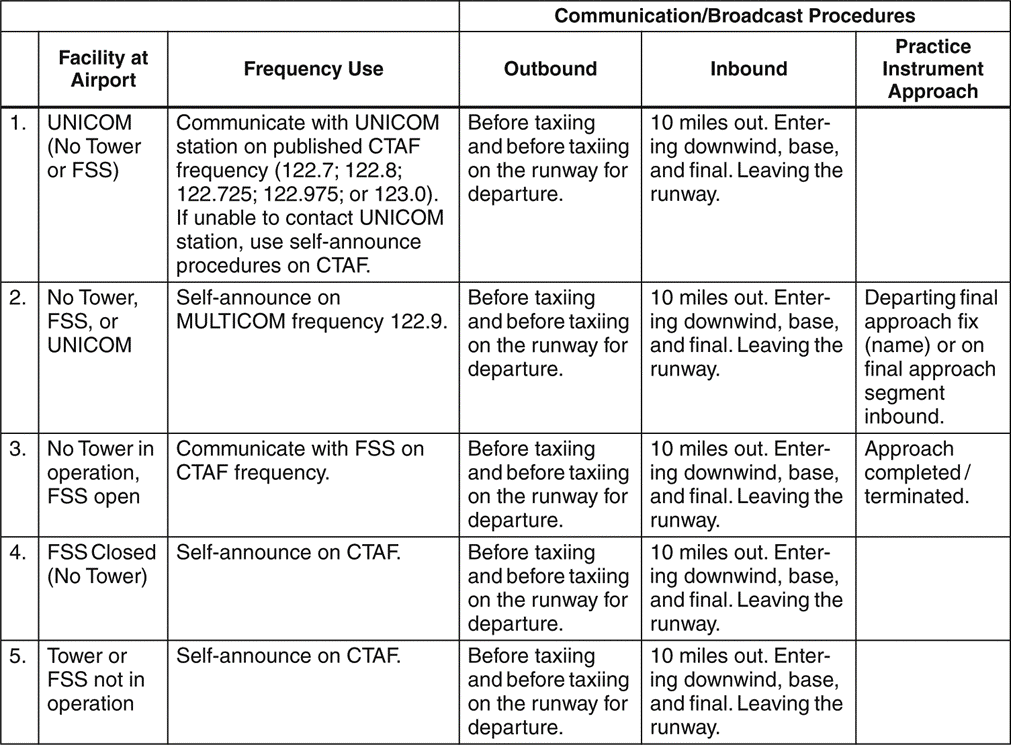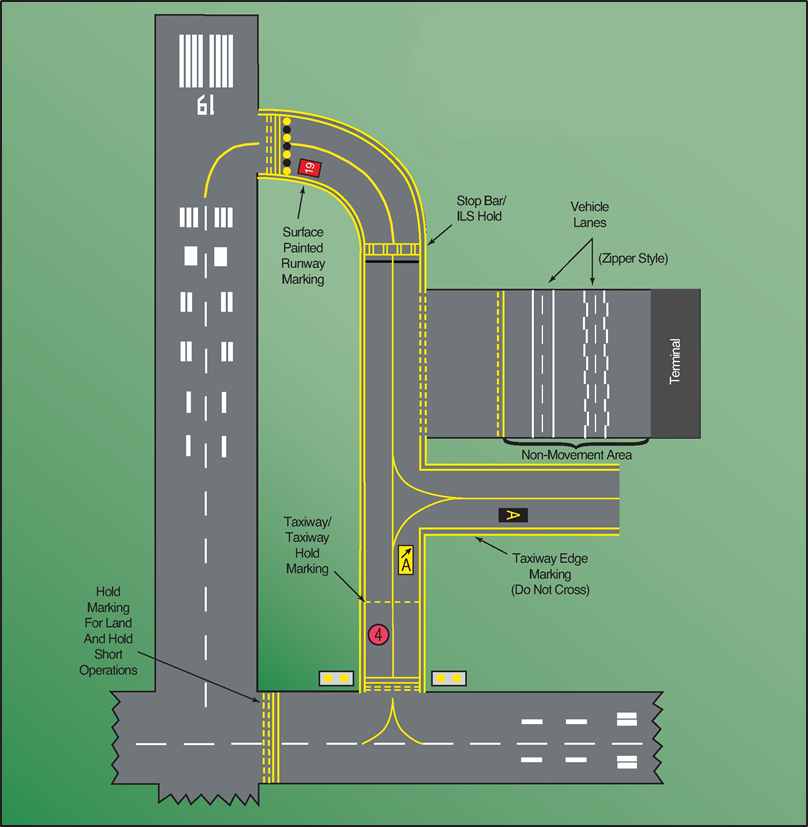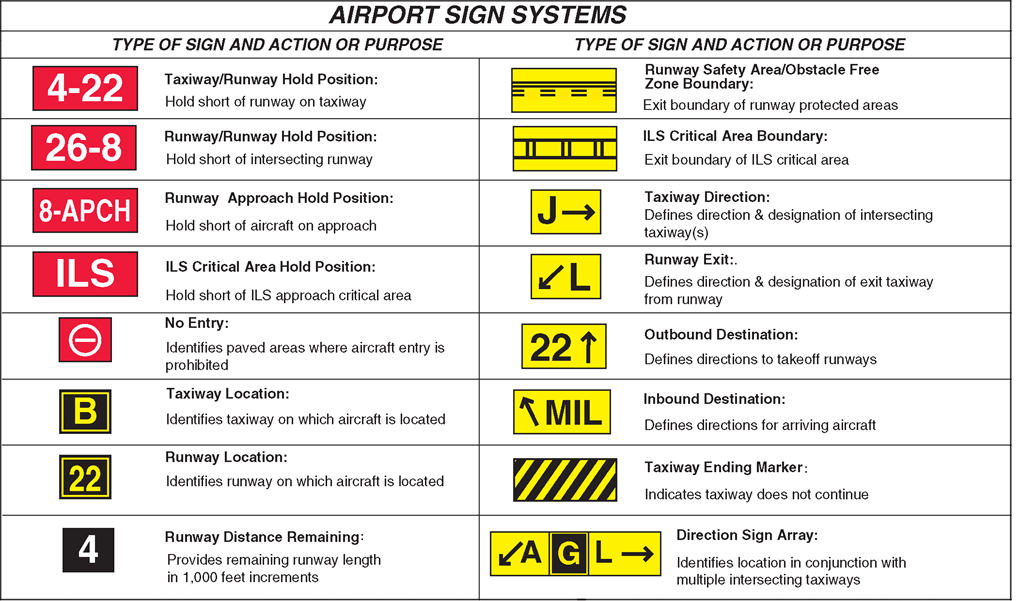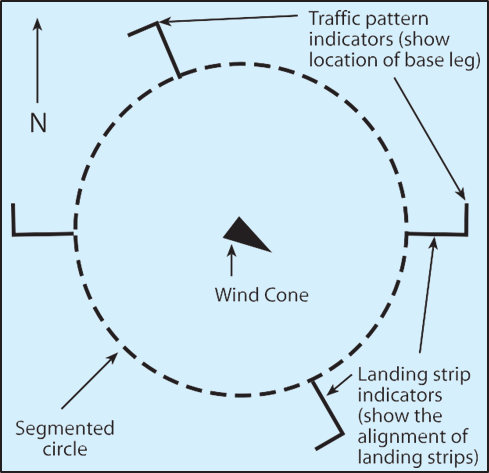It is very important to note 14 CFR part 91 requires powered parachutes to avoid the flow of fixed-wing aircraft. Additional information on airport operations can be found in the Aeronautical Information Manual (AIM) and the Pilot’s Handbook of Aeronautical Knowledge.
Airport Traffic Patterns and Operations
Every flight begins and ends at an airport; an airport, as defined by the Federal Aviation Regulations, is an area of land or water that is used or intended to be used for the landing and takeoff of aircraft. For this reason, it is essential you learn the traffic rules, procedures, and patterns that may be in use at various airports.
Most aviation accidents occur within a few miles of the airport. This is where congestion is the heaviest and the pilot is the busiest.
“See and avoid” is critical for safe operations. Advisories on the common traffic advisory frequency (CTAF) are essential at non-tower-controlled airports and flying fields to advise other aircraft of your position and intentions.
To enhance safety around airports, specific traffic patterns and traffic control procedures have been established at airports. The traffic patterns provide specific routes for takeoffs, departures, arrivals, and landings. The exact nature of each airport traffic pattern is dependent on the runway in use, wind conditions, obstructions, and other factors.
Different traffic patterns at the same airport may be established for heavy aircraft, general aviation aircraft, gliders and light-sport aircraft (LSA) operations. The largest factor in determining the proper traffic pattern is airspeed. Slow aircraft do not mix well with fast aircraft. The powered parachute is at the slow end of the speed range of aircraft found around most airports. Regardless of the traffic pattern flown, you must be aware of your position relative to other aircraft in the traffic pattern and avoid the flow of fixed-wing aircraft. Helicopters fall under this same rule. This rule frequently affects the choice for a landing site. Refer to Chapter 5 for more information on selecting a landing site and airport operation information.
With that in mind, you must understand the standard airport traffic pattern in use at the airport you are operating at and the traffic pattern you are flying to maintain separation from other aircraft traffic.
Powered parachutes operate best from a grass surface, due to less wear and tear on the canopy. However, off-runway operation may disrupt normal airport operations and may not be safe for the PPC due to poor surface conditions. If an off-runway area is used for PPC operations, examine the area for surface condition, holes, standing water, rocks, vegetation height, moguls, fences, wires and other hazards.
A traffic pattern may be established for an off-runway operating area. The traffic pattern may not, and prob- ably will not, conform to the airplane traffic pattern. It is still your responsibility to avoid the flow of airplane traffic.
If you elect to use the airport runway, take into consideration any crosswind that may be present. The airport runway may not be aligned close enough into the wind for your flying skills or may exceed the canopy limitations.
The established powered parachute traffic pattern for an airport might be similar to the standard traffic pattern or it might use turns in the opposite direction. [Figure 10-1] In both cases, use a standard rectangular pattern with a pattern altitude of one-half the airplane traffic pattern altitude or as published (if published). An airport may also use a smaller pattern, referred to as a “tight pattern” or “inside pattern,” and it might be in the same direction as the other traffic or opposite. This smaller pattern combined with a pattern altitude of one-half the airport traffic pattern helps ensure separation from aircraft flying much faster. It is important to review the Airport/Facilities Directory (A/FD) and understand the procedures used at each airport you will be operating at.

Figure 10-1. Traffic patterns.
Airports vary in complexity from small, private grass or sod strips to public major terminals having many paved runways and taxiways. Regardless of the type of airport or field, you must know and abide by the rules and general operating procedures applicable to the airport being used. These rules and procedures are based not only on logic or common sense but also on courtesy. The objective is to keep air traffic moving with maximum safety and efficiency. The use of any traffic pattern, service, or procedure does not alter the responsibility for you to see and avoid other aircraft.
Control towers and radar facilities provide a means of adjusting the flow of arriving and departing aircraft, and render assistance to pilots in busy terminal areas. You must be familiar with the communication requirements for operating at airports where you operate or intend to operate. [Figure 10-2]Airport lighting, markings, and signs are used frequently to alert pilots to abnormal conditions and hazards, provide directions, and assist pilots in airport operations. It is essential you understand and ad- here to the information provided by these indicators. [Figures 10-3 and 10-4]
Standard Airport Traffic Patterns
The regulations require powered parachutes avoid the flow of fixed-wing aircraft. This rule should be the primary factor in deciding whether a standard airport traffic pattern is appropriate for your operation.
To assure that air traffic flows into and out of an airport in an orderly manner, an airport traffic pattern is established appropriate to the local conditions, including the direction and placement of the pattern, the altitude to be flown, and the procedures for entering and leaving the pattern. Unless the airport displays approved visual markings indicating that turns should be made to the right, you should make all turns in the pattern to the left. Again, the airport may have established a different pattern and altitude for LSA operations; be sure to talk with the airport manager and check the A/FD before heading to the airport.
When operating at an airport with an operating control tower, you will receive by radio a clearance to approach or depart, as well as pertinent information about the traffic pattern. If there is not a control tow- er, it is your responsibility to determine the direction of the traffic pattern, to comply with the appropriate traffic rules, and to display common courtesy toward other pilots operating in the area. The common Traffic Advisory Frequency (CTAF) is a good place to listen for traffic at the airport. It is also important to listen to the automatic terminal information service (ATIS) if one is provided.

Figure 10-2. Recommended communication procedures at uncontrolled airports.
You are not expected to have extensive knowledge of all traffic patterns at all airports, but if you are familiar with the basic rectangular pattern, it will be easy to make proper approaches and departures from most airports, regardless of whether they have control towers. Check the Airport/Facility Directory for airport and traffic pattern information.At airports with operating control towers, the tower operator may instruct you to enter the traffic pattern at any point or to make a straight-in approach without flying the usual rectangular pattern. Many other deviations are possible if the tower operator and the pilot work together in an effort to keep traffic moving smoothly. Jets or heavy aircraft will frequently be flying wider and/or higher patterns than lighter aircraft, and in many cases will make a straight-in approach for landing.
The standard general aviation (GA) rectangular traffic pattern is illustrated in Figure 10-1. Traffic pattern altitude can vary by airport and should be checked in the Airport/Facility Directory. The GA pattern altitude is typically 800 – 1,000 feet. The PPC should NOT be flown at the GA pattern altitude. In an effort to avoid airplanes, the PPC pattern altitude should be one-half the GA pattern altitude. Even after the airplane has slowed to traffic pattern speed, it is still 2 to 3 times the PPC speed. When entering the traffic pattern at an airport without an operating control tower, inbound pilots are expected to observe other aircraft already in the pattern and to conform to the traffic pattern in use. If other aircraft are not in the pattern, then traffic indicators on the ground and wind indicators must be checked to determine which runway and traffic pattern direction should be used. Many airports have L-shaped traffic

Figure 10-3. Selected airport markings.
pattern indicators displayed with a segmented circle adjacent to the runway. [Figure 10-5] The short member of the L shows the direction in which the traffic pattern turns should be made when using the runway parallel to the long member. Check these indicators while at a distance well away from any pattern that might be in use, or while at a safe height well above airport pattern altitudes. Once the proper traffic pat- tern direction has been determined, you should then proceed to a point well clear of the pattern before descending to the pattern altitude.
When approaching an airport for landing, the traffic pattern should be entered at a 45° angle to the downwind leg, headed toward a point abeam of the midpoint of the runway to be used for landing. Arriving aircraft should be at the proper traffic pattern altitude before entering the pattern, and should stay clear of the traffic flow until established on the entry leg. Entries into traffic patterns while descending create specific collision hazards and should always be avoided.
The entry leg should be of sufficient length to provide a clear view of the entire traffic pattern, and to allow you adequate time for planning the intended path in the pattern and the landing approach.The downwind leg is a course flown parallel to the landing runway, but in a direction opposite to the intended landing direction. This leg should be at onehalf the specified traffic pattern altitude to alleviate conflicts with faster aircraft. During this leg, the before landing check should be completed. Maintain pattern altitude until abeam the approach end of the landing runway. At this point, reduce power and begin a descent. The downwind leg continues past a point abeam the approach end of the runway to a point approximately 45° from the approach end of the runway, and a medium bank turn is made onto the base leg.

Figure 10-4. Airport signs.

Figure 10-5. Segmented circle and components.
The base leg is the transitional part of the traffic pattern between the downwind leg and the final approach leg. Depending on the wind condition, it is established at a sufficient distance from the approach end of the landing runway to permit a gradual descent to the intended touchdown point. The ground track of the powered parachute while on the base leg should be perpendicular to the extended centerline of the landing runway, although the longitudinal axis of the powered parachute may not be aligned with the ground track when it is necessary to turn into the wind to counteract drift. While on the base leg, the pilot must ensure, before turning onto the final approach, that there is no danger of colliding with another aircraft that may already be on the final approach.
The final approach leg is a descending flightpath starting from the completion of the base-to-final turn and extending to the point of touchdown. This is probably the most important leg of the entire pattern, be- cause here the pilot’s judgment and procedures must be the sharpest to accurately control the airspeed and descent angle while approaching the intended touch-down point.
As stipulated in 14 CFR part 91, section 91.113, aircraft while on final approach to land or while landing have the right-of-way over other aircraft in flight or operating on the surface. When two or more aircraft are approaching an airport for the purpose of landing, the aircraft at the lower altitude has the right-of-way. Pilots should not take advantage of this rule to cut in front of another aircraft that is on final approach to land, or to overtake that aircraft.
The upwind leg is a course flown parallel and in the same direction to the landing runway. The upwind leg continues past a point abeam the departure end of the runway where a medium bank 90° turn is made onto the crosswind leg.
The upwind leg is also the transitional part of the traffic pattern: the final approach, when a go-around is initiated, and where climb attitude is established af- ter lift-off. When a safe altitude is attained, the pilot should commence a shallow bank turn to the cross-wind leg of the airport. The go-around is flown much as you would overtake an aircraft by passing the over- taken aircraft on their right. This will allow better visibility of the runway for departing aircraft.
The departure leg of the rectangular pattern is a straight course aligned with, and leading from, the takeoff runway. This leg begins at the point the powered parachute leaves the ground and continues until the 90° turn onto the crosswind leg is started.On the departure leg after takeoff, continue climbing straight ahead, and, if remaining in the traffic pattern, commence a turn to the crosswind leg. The published airport traffic pattern may describe the turn to cross-wind by altitude or ground reference. Begin the turn to crosswind after a positive rate of climb has been established and sufficient altitude has been gained to allow clearance from ground obstructions.
If departing the traffic pattern, continue straight out or exit with a 45° turn, to enter the upwind leg after a positive rate of climb has been established and sufficient altitude has been gained to allow clearance from ground obstructions. Exit the upwind leg straight out. Turning into the upwind leg allows the PPC to exit the pattern and avoid airplanes in the traffic pattern. Care should be taken not to turn into the path of an aircraft in the upwind leg.
If parallel operations are in place (i.e., airplanes on the hard surface, powered parachutes on the grass), fly a pattern that stays within the pattern of the airplane traffic and does not cross the airplanes’ active runway. In all cases, the powered parachute should not make any turns until the pilot is certain it will not obstruct any aircraft operating in either pattern.
The crosswind leg is the part of the rectangular pattern that is horizontally perpendicular to the extended centerline of the takeoff runway and is entered by making approximately a 90° turn from the upwind leg. On the crosswind leg, the powered parachute proceeds to the downwind leg position.
Since takeoffs are usually made into the wind, the wind will now be approximately perpendicular to the powered parachute’s flight path. As a result, the powered parachute will have to be turned or headed slightly into the wind while on the crosswind leg to maintain a ground track that is perpendicular to the runway centerline extension.





